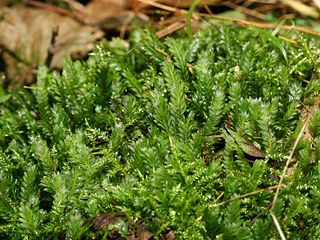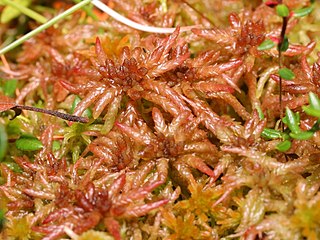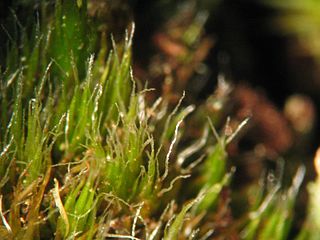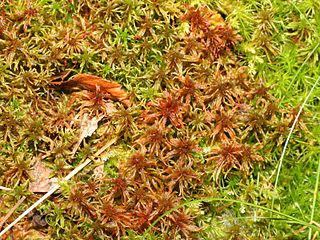
Fissidens adianthoides, the maidenhair pocketmoss, is a moss in the family Fissidentaceae. It was first collected by Hedwig in 1801.

Pleurozium schreberi, the red-stemmed feathermoss or Schreber's big red stem moss, is a moss with a loose growth pattern. The root name pleuro comes from the Latin for ribs, possibly describing how the parts branch from the stem.
Rhytidiadelphus triquetrus, the big shaggy-moss or rough goose neck moss, is a species of moss in the family Hylocomiaceae. It is often the dominating moss species in moderately rich forest habitats in the boreal regions and the Pacific Northwest. Because of its fuzzy appearance and tail-like shape it is also called the 'electrified cat's tail moss'. Not to be confused with square goose-necked moss, Rhytidiadelphus squarrosus.

Helodium blandowii, also known as Blandow's helodium moss, Blandow's tamarisk-moss, Blandow's bogmoss, and Blandow's feathermoss, is a rare plant in the Western U.S., including Oregon and California. It occurs all around the northern hemisphere in higher latitudes, and in some places is not as rare as in the Western U.S.

Sphagnum magellanicum, commonly called Magellanic bogmoss, Magellan's sphagnum, Magellan's peatmoss or midway peat moss, is a widespread species of moss found in wet boreal forest in the far south and southwest of South America, North America and Eurasia.

Campylopus introflexus, also known as the heath star moss, is a species of moss. The first description of the species was made by Johannes Hedwig as Dicranum introflexum in 1801.

Potamogeton polygonifolius or bog pondweed, is an aquatic plant. It is found in shallow, nutrient-poor, usually acid standing or running water, bogs, fens and occasionally ditches.

Rhytidiadelphus squarrosus is a species of moss known as springy turf-moss in the United Kingdom, and square goose neck moss in the United States. It is widespread in Eurasia and North America, and has been introduced to the Southern Hemisphere. It has broad ecological tolerances, and is usually found in man-made habitats such as lawns and golf courses. It is most closely related to R. subpinnatus, with which it is often confused.

Zygodon gracilis, the slender yokemoss, is a moss species in the genus Zygodon. It is a rare lithophyte found to only grow on certain localities of limestone outcrops that has high calcium carbonate content. The current global conservation status of Z. gracilis is considered to be "imperiled".

Sphagnum cuspidatum, the feathery bogmoss, toothed sphagnum, or toothed peat moss, is a peat moss found commonly in Great Britain, Norway, Sweden, the eastern coast of the United States, and in Colombia.

Fissidens limbatus commonly known as Herzog's pocket-moss, is a moss in the family Fissidentaceae. This species is found growing in high elevations in tropical America in addition to the US, Mexico and Canada. Montagne first collected F. crispus in 1838.

Warnstorfia fluitans, the floating hook-moss or water hook-moss, is a species of moss found in acidic habitats across all continents except Antarctica.

Plagiomnium venustum, also known as magnificent leafy moss, is a species of moss belonging to the family Mniaceae. It is found mainly in western North America along the coastal region. This moss can be identified from other members of the Plagiomnium genus by dark coloured stomata guide cells and the absence of sterile stems. It is most commonly found growing as a mat on a variety of substrate, but mainly on humus and moist soil.

Polytrichum piliferum, the bristly haircap, is an evergreen perennial species of moss in the family Polytrichaceae. The bristly haircap moss is small-sized to medium-sized and forms loose tufts with wine-reddish stems. It is an acrocarpous moss that appears bluish-green to grey. This moss grows in clumps on erect shoots and becomes a red-brown colour as it grows older. The most distinguishing feature of P. piliferum is the long, white awn at the tips of the leaves, which also give this moss its grey colour. It is the only species in its genus where the awn is completely hyaline.
Sphagnum denticulatum is a species of moss belonging to the family Sphagnaceae. It is widely distributed in Europe but it is also found in other parts of the world.

Sphagnum warnstorfii is a species of moss belonging to the family Sphagnaceae. It is widely distributed in the north hemisphere.

Philonotis seriata is a species of moss belonging to the family Bartramiaceae. It is widely distributed in Europe but it is also found in other parts of the world.

Hypnum jutlandicum is a species of moss belonging to the family Hypnaceae. It is widely distributed in Europe and the Aleutian islands but it is also found in other parts of the world.
Atrichum crispum is a species of moss. It is dioicous with males being the same size as females or larger.
















